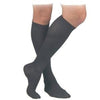Translation missing: en.collections.general.collection_label: Best Diabetic Compression Stockings & Support Hose Socks - 2025
To make our Best Best Diabetic Compression Stockings List, these products have met our three criteria:
- They have been out in the marketplace for at least three years.
- Manufactured to the highest quality standards.
- Foot care professionals involved with treating diabetic foot care on a daily basis have recommended these socks.
HERE’S OUR LIST OF THE TOP 5 DIABETIC SOCKS FOR MEN IN 2025:
Men’s White Compression Stockings
Women's Black Compression Hose
Men’s Navy Compression Stockings
Women's Tan Compression Hose
Men’s Brown Compression Stockings
We offer special socks called compression stockings that apply light pressure to your ankles and legs to enhance blood flow from your legs to your heart. They also lessen leg pain and swelling.
But why should YOU put them on? Compression stockings can help you manage the symptoms of nerve or vein disorders like varicose veins, neuropathy, or edema and improve the ease with which your feet, legs, and ankles function.
So if you're looking for a straightforward yet stylish look, Diabetic Sock Club Over The Calf Compression Stockings is fantastic! They are available in tan, brown, gray, black, white, navy, and many more colors, so you may choose one that matches your outfit. Your ankles and feet will feel the majority of the pressure from these stockings, which lessens as it moves upward.
These are composed of the highest-quality materials, which are also oh-so-soft, warm, and capable of wicking away perspiration. These qualities can aid in preventing the growth of unpleasant odors brought on by moisture, which can cause major foot issues including blisters. Plus they are 100% made in the U.S.A.
-
Men's Over The Calf Compression Stocking Socks (1 Pair) - Large (shoe size 10-12) / White / 20-30mmhg (high)
- Translation missing: en.products.product.regular_price
- $41.95
- Translation missing: en.products.product.sale_price
- $29.99






-
Men's Over The Calf Compression Stocking Socks (1 Pair) - Large (shoe size 10-12) / Black / 15-20mmHg (medium)
- Translation missing: en.products.product.regular_price
- $41.95
- Translation missing: en.products.product.sale_price
- $24.99






-
Men's Over The Calf Compression Stocking Socks (1 Pair) - Large (shoe size 10-12) / Navy / 15-20mmHg (medium)
- Translation missing: en.products.product.regular_price
- $41.95
- Translation missing: en.products.product.sale_price
- $24.99






-
Men's Over The Calf Compression Stocking Socks (1 Pair) - Large (shoe size 10-12) / Brown / 20-30mmhg (high)
- Translation missing: en.products.product.regular_price
- $41.95
- Translation missing: en.products.product.sale_price
- $29.99






-
Men's Over The Calf Compression Stocking Socks (1 Pair) - Large (shoe size 10-12) / Grey / 8-15mmHg (low)
- Translation missing: en.products.product.regular_price
- $31.95
- Translation missing: en.products.product.sale_price
- $19.99






-
Men's Over The Calf Compression Stocking Socks (1 Pair) - Medium (shoe size 8-10) / Tan / 20-30mmhg (high)
- Translation missing: en.products.product.regular_price
- $41.95
- Translation missing: en.products.product.sale_price
- $29.99






-
Women's Over The Calf Compression Stocking Socks (1 Pair) - Medium (shoe size 7-10) / White / 20-30mmhg (high)
- Translation missing: en.products.product.regular_price
- $51.95
- Translation missing: en.products.product.sale_price
- $29.99






-
Women's Over The Calf Compression Stocking Socks (1 Pair) - Medium (shoe size 7-10) / Black / 20-30mmhg (high)
- Translation missing: en.products.product.regular_price
- $51.95
- Translation missing: en.products.product.sale_price
- $29.99






-
Women's Over The Calf Compression Stocking Socks (1 Pair) - Medium (shoe size 7-10) / Brown / 20-30mmhg (high)
- Translation missing: en.products.product.regular_price
- $51.95
- Translation missing: en.products.product.sale_price
- $29.99






-
Women's Over The Calf Compression Stocking Socks (1 Pair) - Medium (shoe size 7-10) / Grey / 8-15mmHg (low)
- Translation missing: en.products.product.regular_price
- $31.95
- Translation missing: en.products.product.sale_price
- $19.99






-
Women's Over The Calf Compression Stocking Socks (1 Pair) - Medium (shoe size 7-10) / Tan / 20-30mmhg (high)
- Translation missing: en.products.product.regular_price
- $51.95
- Translation missing: en.products.product.sale_price
- $29.99






-
Women's Over The Calf Compression Stocking Socks (1 Pair) - Large (shoe size 10-13) / Navy / 15-20mmHg (medium)
- Translation missing: en.products.product.regular_price
- $41.95
- Translation missing: en.products.product.sale_price
- $24.99


















